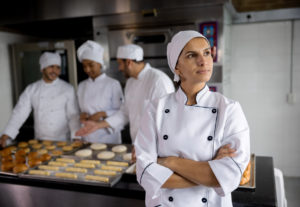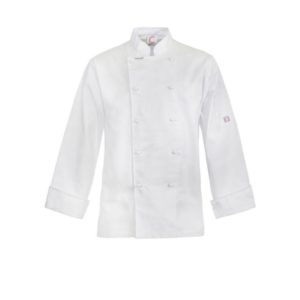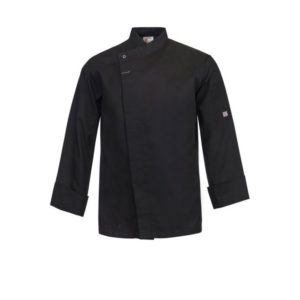
The chef uniforms, as we know them today, have a rich history dating back to the 19th century. The iconic white chef jackets was first donned by Chef Marie-Antoine Carême, who chose the color white to signify cleanliness. He also introduced the chef’s hat, known as a toque, with different heights signifying the wearer’s rank in the kitchen. The use of double-breasted jackets was another practical innovation, offering protection from hot splashes in the kitchen. These uniforms quickly gained popularity and became the standard in the industry, symbolizing professionalism and adherence to high standards of hygiene.

The Role of Chef Uniforms in the Hospitality Industry
Chef uniforms play a significant role in the hospitality industry beyond their aesthetic function. Their design is fundamentally rooted in practicality and safety. The double-breasted jacket can be reversed to hide stains, maintaining a professional appearance throughout the service. The thick cotton fabric provides a good insulator against kitchen hazards such as hot spills and splashes. Furthermore, the knotted cloth buttons endure the rigors of daily wear and frequent washing better than typical plastic buttons. Meanwhile, the chef’s trousers, traditionally in a black-and-white houndstooth pattern, are designed to camouflage minor spills and stains.
On a broader level, chef uniforms contribute to establishing and reinforcing the identity and brand of a restaurant. Hospitality Uniforms signify unity and create a sense of belonging among staff members. They also carry an air of authority and competence, assuring customers of the level of professionalism and commitment to hygiene and food safety in the kitchen. Thus, chef uniforms are vitally important in the overall operation and success of the hospitality industry.
Chef Uniforms and Food Safety: The Indispensable Connection
Chef uniforms are not mere garments; they symbolize the critical role of food safety in the culinary world. The clean, white coat is a constant reminder of the importance of maintaining sanitation in a bustling kitchen. The thick fabric of the jacket offers protection against hot spills, burns, and even the sharp edges of kitchen tools, thereby ensuring that meal preparation is conducted in a safe manner. Moreover, long sleeves may prevent loose hairs or sweat from contaminating the food. The traditional toque, besides indicating a chef’s rank, serves the practical purpose of keeping hair away from food, averting potential hygiene issues. Even the chef’s apron plays a role, providing an extra layer of protection and a quick way to wipe off hands in the fast-paced kitchen environment.
Therefore, every element of the chef’s uniform contributes to food safety measures, making it an integral part of any serious culinary establishment. Thus, the chef uniform is not just a symbol of professionalism and authority, but also a practical tool in maintaining hygiene and food safety.
- Protection Against Burns and Spills: The thick cotton material used in chef uniforms is designed to provide a first layer of defense against hot spills, splashes, and flames. It can protect chefs from minor burns, reducing the risk of accidents in the kitchen.
- Maintaining Hygiene: Chef uniforms are specifically designed to maintain cleanliness in the kitchen. The double-breasted jacket can be reversed to hide stains, ensuring that chefs appear clean and professional throughout service. This is vital in preventing cross-contamination and maintaining food hygiene standards.
- Heat and Moisture Control: The kitchen is a hot and humid environment. Chef uniforms are made from breathable materials like cotton, which absorb sweat and allow the skin to breathe, keeping chefs cool under pressure and reducing the risk of heat exhaustion.
- Preventing Hair Contamination: The chef’s hat, or toque, is not just a symbol of authority, but also a functional tool for food safety. It ensures hair is kept away from the food, preventing contamination.
- Camouflaging Minor Spills: The trousers of a chef uniform, usually in a black-and-white houndstooth pattern, are designed to hide minor spills and stains. This helps maintain a professional appearance and ensures cleanliness is kept at the forefront.
- Durable Buttons: The knotted cloth buttons on a chef’s jacket are designed to withstand rigorous daily wear and frequent washing. This design ensures the longevity of the uniform, allowing it to maintain its safety and hygiene functions over time.
- Recognition of Roles: Different heights of the toque or colored trim on jackets can indicate rank in the kitchen. This clear delineation of roles can help operations run smoothly, reducing the risk of accidents and ensuring food safety protocols are followed properly.
- Enforcing Discipline and Professionalism: The uniform is also a symbol of professionalism and discipline, crucial for maintaining high standards of food safety. The pride in wearing the uniform can foster a greater sense of responsibility among chefs, encouraging strict adherence to hygiene and safety protocols.
The Role of Different Parts of the Uniform in Ensuring Safety
Each component of the chef’s uniform serves a distinct purpose in promoting safety within the kitchen. The double-breasted jacket offers a guard against hot spills and splashes, and its reversible design aids in maintaining cleanliness throughout service hours. The thick cotton material of the jacket, trousers, and apron provides insulation from heat and flames, reducing the risk of burns.
The chef’s trousers, traditionally designed in a houndstooth pattern, conceal minor spills and stains, ensuring continuous professionalism. Meanwhile, the toque, or chef’s hat, prevents hair from straying into the food, eliminating a potential contamination source. Its varying heights also indicate a chef’s rank, streamlining kitchen operations and reducing chances of mishaps.
Lastly, the knotted cloth buttons, robust to withstand rigorous daily wear and frequent washing, ensure the longevity of the uniform, preserving its safety and hygiene functions. The uniform’s collective parts underscore the industry’s commitment to safety, hygiene, and operational efficiency, making it not just a dress code, but a critical aspect of the culinary world.
The Changing Trends in Chef Uniforms
- Introduction of New Materials: Modern chef uniforms often incorporate new materials like polyester and polycotton, which are more durable and easier to clean than traditional cotton.
- Incorporation of Comfort Features: Current trends show an increase in chef uniforms that prioritize comfort, such as ventilated jackets and adjustable waistbands, to accommodate chefs working long hours.
- Variety in Colors: While white remains the conventional color, there is a growing trend of chef uniforms in various colors, allowing establishments to match their brand or cuisine aesthetics.
- Stylish Designs: Today’s chef uniforms reflect a balance between tradition and modernity, with sleek cuts and stylish designs becoming more prevalent.
- Inclusion of Women’s Wear: As more women enter the culinary industry, the demand for women’s chef uniforms has grown, leading to uniforms designed specifically to fit and flatter women’s bodies.
- Personalized Chef Uniforms: There is a rising trend of personalized chef uniforms, featuring embroidered names or logos, allowing chefs to display their personal style.
- Sustainability: Environmental consciousness has led to an increase in demand for chef uniforms made from sustainable materials, like recycled polyester or organic cotton.
- Technological innovations: Technology has influenced the design of chef uniforms, with features like stain-resistant and wrinkle-free materials, and fabrics that offer UV protection or temperature regulation.
Best Chef Jackets by WorkArmour –
Lightweight Executive White Chefs Jacket – Long Sleeve

WorkArmour’s Lightweight Executive White Chefs Jacket – Long Sleeve is a perfect blend of tradition, comfort, and durability. Crafted from premium lightweight polycotton, the jacket offers superior breathability and comfort, essential for lengthy shifts in the high-temperature kitchen environment. The long sleeves provide added protection against hot spills and splashes, while the traditional double-breasted design ensures quick reversibility to maintain a clean, professional appearance. The jacket features a sleek, modern cut, reflecting the current trend of balancing tradition with style. It is also designed to withstand rigorous washing, preserving its pristine white color and maintaining its safety functions over time. This jacket is an excellent choice for chefs seeking a blend of functionality, comfort, and modernity in their uniform.
Black Chefs Tunic – With Concealed Front and Long Sleeves

The Black Chefs Tunic – With Concealed Front and Long Sleeves from WorkArmour is designed for chefs who value comfort, style, and functionality. Made from durable polycotton fabric, this tunic offers excellent breath-ability and comfort for long hours in the kitchen. The concealed front and long sleeves offer full-coverage protection against hot splashes, while the solid black color helps camouflage minor spills and stains. The tunic features a contemporary design, aligning with the modern trend of stylish yet practical chef uniforms. Its robust construction ensures it keeps its shape and color despite frequent washing, maintaining its professional appearance and safety functions. For chefs looking for a modern, stylish, and practical addition to their uniform, this tunic is an outstanding choice.
The Future of Chef Uniforms in the Hospitality Industry
As we look towards the future, the evolution of chef uniforms in the hospitality industry is expected to continue, focusing on a combination of function, fashion, and sustainability. Advancements in fabric technology will likely lead to uniforms that are more durable, stain-resistant, and climate-controlled, serving the dual purpose of comfort and protection in high-pressure kitchen environments.
The rise of customization and personal branding may result in uniforms becoming a personal statement for chefs, showcasing individual style and identity. This could range from unique color palettes to bespoke embroideries. Moreover, the increasing presence of women in the industry will continue to drive the demand for more gender-inclusive designs, catering to various body types and promoting comfort and confidence in the kitchen.
Sustainability will also continue to be a significant influence on the future of chef uniforms. As the hospitality industry becomes more conscious of its environmental impact, we can anticipate an increase in uniforms made from recycled or organic materials. This shift towards eco-friendly practices will not only reduce the industry’s carbon footprint but also resonate with a new generation of chefs and patrons increasingly mindful of sustainability.
In summary, the future of chef uniforms lies in balancing tradition with modernity, functionality with style, and innovative practices with sustainability, reflecting the ongoing evolution of the hospitality industry.




